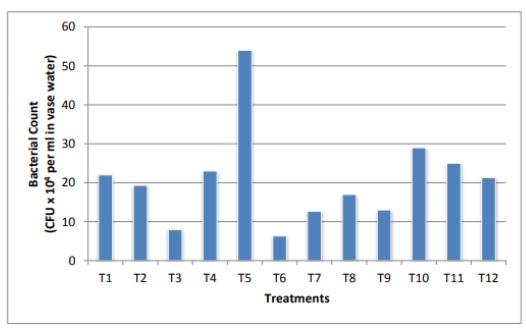The Bacterial Effect on Xylem Blockage in Rose during Postharvest Life
DOI:
https://doi.org/10.5281/zenodo.10567800Keywords:
bacterial effect, blockage, roseAbstract
One of the most popular cut flowers in the world is the rose. An obstacle is that cut roses have a naturally short vase life. One of the main causes of shortened vase life is microbial contamination. This study assessed the effects of nanoparticle vase holding solutions on Taj Mahal rose variety water relations and microbial load. The Postharvest Technology Laboratory, College of Horticulture, Bengaluru, is where the current study was conducted. Water absorption, transpiration loss, water balance, and microbiological load were all measured during the vase time. The greatest options for preserving water relationships and preventing bacterial growth were nanosilver treatments. The best benefits were seen in flowers that were kept in 50 ppm nanosilver. This study reveals the fact that, in the present context, silver nanoparticles are one of the best available technologies in delaying the postharvest associated degradation in rose cut flowers.
Downloads
References
Shah, M. A., & A. Tokeer. (2010). Principles of nanoscience and nanotechnology. New Delhi: Naroosa Publishing House.
Fresta, M., Puglisi, G., Giammona, G., Cavallaro, G., Micali, N., & Furneri, P. M. (1995). Pefloxacine mesilate- and ofloxacin loaded polyethylcyanoacrylate nanoparticles: characterization of the colloidal drug carrier formulation. J. Pharm. Sci., 84, 895–902.
Van Doorn, W. G. (1997). Water relations of cut flowers. Hort. Rev., 18, 1-85.
Jedrzejuk, A., & J. Zakrzewski. (2009). Xylem occlusions in the stems of common lilac during postharvest life. Acta Physiol. Planta., 31(6), 1147–1153.
Ichimura, K., & Shimuzu, H. Extension of the vase life of cut rose by treatment with sucrose before and during simulated transport. Bulletin of the National Institute of Floricultural Science, 7, 17–27.
Louband, M., & Van Doorn, W. G. (2004). Wound-induced and bacteriainduced xylem blockage in rose, Astilbe, and Viburnum. Postharvest Biol. Technol., 32, 281-288.
Liu Jiping, Shenggen He, Zhaoqi Zhang, Jinping Cao, Peitao, L. V., Sudan, H. E., Cheng, G., & Joyce C, D. (2009). Nano-silver pulse treatments inhibit stem-end bacteria on cut gerbera cv. Ruikou flowers. Postharvest Biol. Technol., 54, 59–62.
Rana, S., & Kalaichelvan, P. T. (2011). Antibacterial effect of metal nanoparticles. Advanced Biotech., 11(2), 21-23.
Jowkar Mohammad Mahdi, Ahmad Khalighi, Mohsen Kafi, & Nader Hassanzadeh. (2013). Nano silver application impact as vase solution biocide on postharvest microbial and physiological properties of ‘Cherry Brandy’ rose. J. Food Agri. Envt., 11(1), 1045-1050.
Niemietz, C. M., & Tyerman, S. D. (2002). New potent inhibitors of aquaporins: silver and gold compounds inhibit aquaporins of plant and human origin. FEBS Lett., 531(3), 443–447.
Liu Jiping, Kamani Ratnayake, Daryl c. Joyce, Shenggen He, & Zhaoqi Zhang. (2012). Effects of three different nano-silver formulations on cut Acacia holosericea vase life. Postharvest Biol. Technol., 66, 8-15.
Balakrishna, H. V., R. T. Venkatesh, & Muthappa, R. B. G. (1989). Postharvest physiology of cut tuberose as influenced by some metal salts. Mysore J. Agril. Sci., 23, 344-348.
Lu, P., J. Cao, S. He, J. Liu, H. Li, G. Cheng, Y, Ding, & Joyce, D. C. (2010). Nanosilver pulse treatments improve water relations of cut rose cv. Movie Star flowers. Postharvest Biol. Technol., 57, 196-202.
Hassan, F. A. S., Ali, E. F., & El-Deeb, B. (2014). Improvement of postharvest quality of cut rose cv. ‘First Red’ by biologically synthesized silver nanoparticles. Sci. Hort., 179, 340-348.
Kader Abdel Hesham, H. (2012). Effects of nanosilver holding and pulse treatments, in comparison with traditional silver nitrate pulse on water relations and vase life and quality of the cut flowers of Rosa hybrida L. cv. 'Tineke. World Appl. Sci. J., 20(1), 130-137.
Paul, N., Syed, A., Vyawahare, P., Dakle, R., & Ghuge, B. (2016). Green approaches for synthesis of zinc nanoparticles and its antibacterial activity. Int. Res. J. Pharm., 7(6), 99-102.

Downloads
Published
How to Cite
Issue
Section
ARK
License
Copyright (c) 2023 Sreenivas B.

This work is licensed under a Creative Commons Attribution 4.0 International License.
Research Articles in 'Applied Science and Biotechnology Journal for Advanced Research' are Open Access articles published under the Creative Commons CC BY License Creative Commons Attribution 4.0 International License http://creativecommons.org/licenses/by/4.0/. This license allows you to share – copy and redistribute the material in any medium or format. Adapt – remix, transform, and build upon the material for any purpose, even commercially.










